Growing orchids is easier than you think! In this detailed orchid plant care guide, I will show you everything you need to be successful.
Find out exactly how to grow orchids, including watering, humidity, soil, fertilizer, repotting, pruning, propagation, reblooming, pest control.
You’ll learn all about them, find out how to troubleshoot common problems, get answers to your FAQs, and so much more.
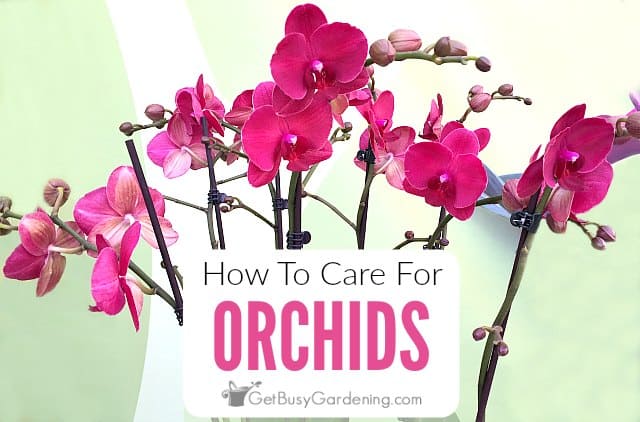
Orchids are fairly easy to care for, and will rebloom year after year in the right conditions.
They make wonderful houseplants, and a collection of several different varieties can reward you with year-round blooms.
The delicate flowers dangling from skinny stems is what makes orchids look so exotic… and it’s also what makes them look like they’d be really hard to grow. But they aren’t as difficult as you may think.
Information About Orchids
To successfully grow orchids, it’s important to understand how they live in nature. Most orchids are epiphytic plants. That means that in their natural habitat they don’t grow in the dirt.
Instead, they attach themselves to logs, rocks, trees, or even other plants. Don’t worry, they don’t feed on those plants, they just use them as a natural growing support.
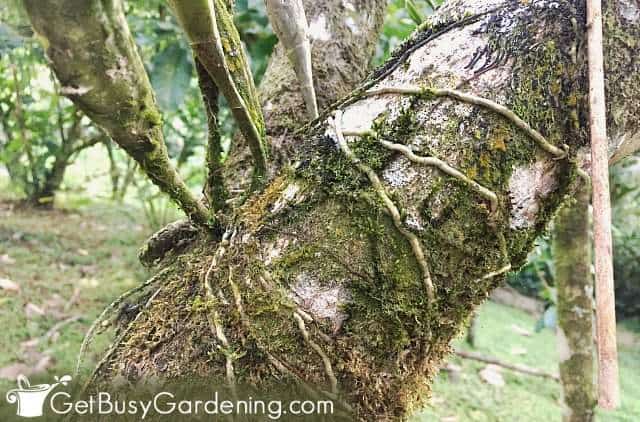
Different Types Of Orchids
There are tons of different varieties of orchids, and they come in all sorts of colors and sizes. Many can be grown as houseplants, though some are fussier than others.
Phalaenopsis orchids (aka: moth orchids) are the most commonly sold variety you will find. That’s because they are the easiest orchids to grow, and perfect for beginners.
Other common varieties that are also pretty easy to grow include Paphiopedilum, Cattleya, Oncidium, Dendrobium, Brassia, Brassavola, and Cymbidium, just to name a few.

Orchid Flowers
Once you get the hang of caring for orchids, and learn the secret to get them to rebloom, they make excellent flowering houseplants.
In most cases orchids bloom during the winter, making them a popular plant sold at garden centers and big box stores around the holidays.
They can bloom for several months, and the flowers will usually last all the way through spring. Some can even bloom year round!
Once they’re done blooming, the flowers will first droop and then naturally drop from the plant, which is totally normal.

How To Grow Orchid Plants
Before we get into the nitty gritty orchid care instructions, it’s important to understand a few things about them first. This way, you’ll set yourself up for the best success right from the start.
Are Orchids Annuals Or Perennials?
Though most commonly sold as houseplants, orchids are actually perennials in their native climate. The hardiness varies depending on the variety you choose to grow.
Some types require a warm, humid environment to survive, while others thrive in colder climates.
So it’s best to know the recommend growing zone of the specific type you have before planting it outside in your garden.
Ideal Orchid Growing Conditions
Since orchids are epiphytes, like bromeliads and staghorn ferns, they need humidity to thrive. Some are more tolerant, and can grow in dryer climates, which makes them ideal indoor plants.
They also grow best when the temperature is between 70-85F degrees, and need bright, indirect light.
Epiphytes also grow best when mounted on a tree, or other sturdy support, or when potted in bark or wood chips.
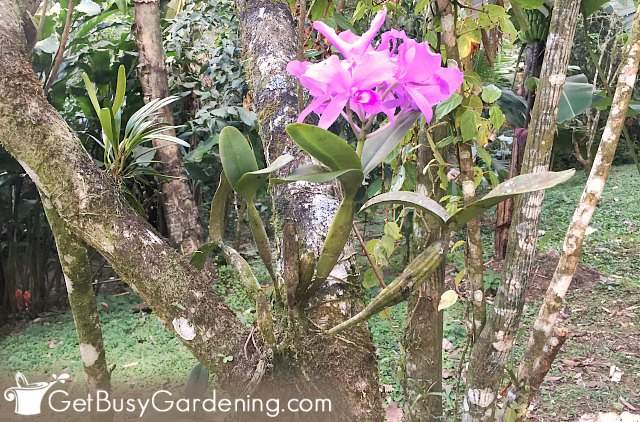
Orchid Plant Care Instructions
Below I’ve broken down my orchid plant care instructions into small chunks to make it easier for you to digest, or simply skim through to find exactly what you’re looking for.
But remember, there are tons of different orchid varieties. So be sure to look up the specific type you have to give them exactly what they need to thrive.
Watering
Most orchids like to be watered consistently, but don’t like soggy feet. Allow the medium to dry out slightly between waterings, but not to the point where the leaves begin to shrivel.
Check the medium weekly to see if it needs to be watered. Then water thoroughly until it starts running out the bottom of the pot, ensuring that all of the medium gets wet.
Some people find it much easier to dunk the entire pot in water rather than pouring it over the top. If you choose to do this, soak the pot until it stops bubbling, but don’t submerge the entire plant.
Whichever method you use, make sure that you allow the water to drain completely from the pot. Never leave your orchid sitting in water for more than a few minutes.
Rainwater or distilled water are the best types to use on orchids. They are sensitive to the chemicals and salts found in tap water, which can build up over time and harm the plant.
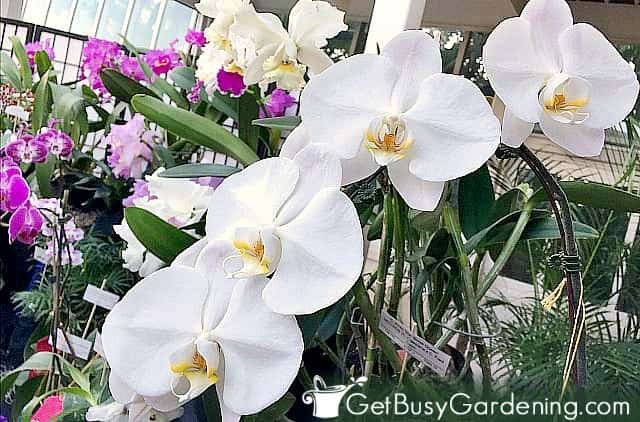
Humidity
Another important part of proper orchid plant care is ensuring they get plenty of humidity.
Because they are epiphytes, high humidity is important for them. Use an indoor humidity monitor so you can see how dry the air is, and modify it as necessary.
Set the plant on a pebble tray to increase humidity, or mist them on a regular basis. Just make sure to do it in the morning so the leaves are dry by the evening to prevent disease or fungus issues.
To increase the humidity levels, you could grow orchids in an indoor mini greenhouse, or place a humidifier in the room near them.

Sunlight
Orchid like bright, indirect light. Never put them in full sun, or it could burn the tender leaves.
Indirect light from a south facing window, or filtered light in a west or east facing window are the best choices.
Outside, you should place them in a partial shade location where they will be protected from the intense afternoon sun.
If you aren’t lucky enough to have the right amount of natural light in your house for growing orchids, you can buy a plant grow light and set it on a timer to give them the perfect amount of light.
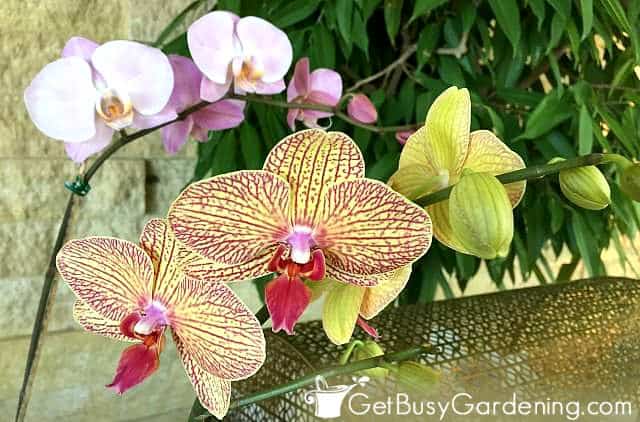
Potting Soil
Since orchids are epiphytes, they get their nutrients and moisture from the air and not the soil. So do not use regular potting soil for them.
The roots need air to survive. Burying the roots in potting soil will cause them to rot, which could eventually kill the plant.
Because they grow on the bark of trees in their natural habitat, an orchid potting medium made from bark would be ideal. Sphagnum moss is also a common medium, and works well for growing orchids.
You could also try mounting yours on a log, tree, or wooden plaque, which looks very cool. But this can make it more difficult to water them, so keep that in mind.
Repotting
Some orchids hate to be repotted, so be sure you only do it when it’s absolutely necessary. Spring and early summer, or after the flowers have died back, are the best times for repotting.
A few signs that yours needs to be repotted are if it looks as if it’s trying to climb out of the pot, lots of roots are growing out of the holes, or it will no longer bloom.
When potting orchids, always use a container that has drainage holes, or you could quickly drown it.
A decorative orchid plant pot is a great option. Or you can simply plant it in a plastic pot, then drop it into the decorative container.
Fertilizing
Orchids will perform their best if you feed them properly. Generally speaking, it’s best to feed them using a weak half or quarter dose of fertilizer every time you water during their active growing season (May-September).
Don’t fertilize orchids during the winter, or while they are flowering. Keep in mind that they are sensitive to chemicals and salts, which can build up in the pot over time.
So I highly recommend that you buy an organic orchid plant food, and follow the directions on the package.
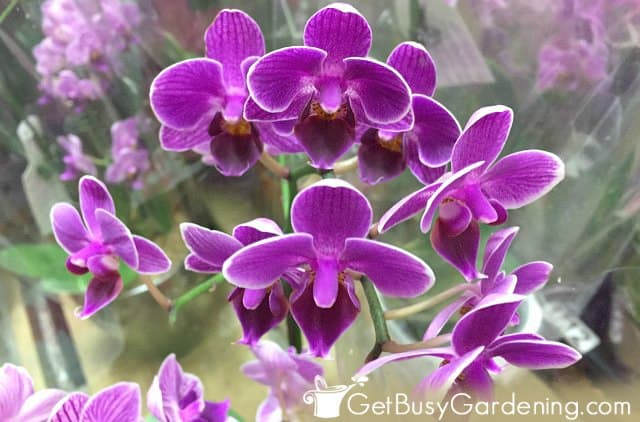
Pest Control
Healthy orchids are usually pretty resistant to houseplant pests, but mealybugs, aphids, or scale can sometimes become a problem.
Organic neem oil is a natural insecticide that is very effective at getting rid of these nasty bugs.
You can also use a cotton swab dipped in rubbing alcohol to kill the pests on contact, or use an insecticidal soap.
Never use synthetic pesticides though, because these bugs can build up a resistance to chemicals, only making the problem worse.
Pruning
In general, orchids don’t require a lot of pruning. If necessary, you can prune off the dead roots or leaves at any time.
Be careful pruning the flower stems though. Some types of orchid plants can bloom several times on one flower spike. So don’t automatically cut it down right after the flowers fall off.
Wait until it turns completely brown, then cut it all the way down to the base of the plant. If the tip of the stem turns brown, then you can trim it back only far enough to remove the dead portion, if desired.
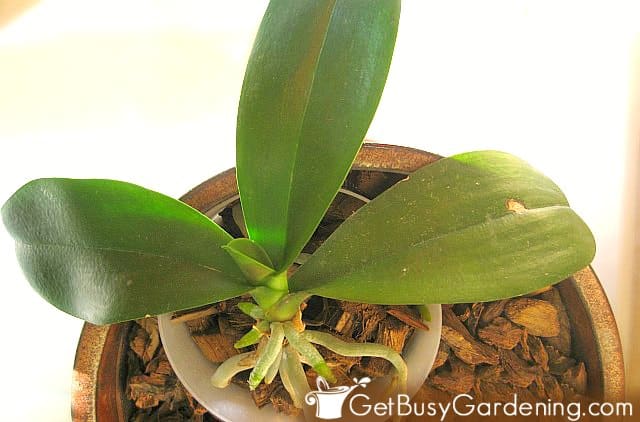
Tips For Reblooming Orchids
Orchids don’t usually rebloom on their own, so you’ll have to help them out a bit. The trick to getting them to bloom is cooler evening temperatures.
Ideally, it should be at least a 10F degrees cooler at night than during the day (but not below 40F) for at least a week. This is easy for those of us who live in cold climates.
When you’re anxiously waiting to see if your orchid will bloom again, it can be hard to tell if the new growth is a flower spike, or just more roots. There is a subtle difference, so look closely.
The roots have smooth and slightly pointed edges. Bloom spikes will have folds at the tips, and they look kinda like a tiny mitten.
If you’ve been religiously following all of these orchid plant care instructions but yours still won’t bloom, that’s a sign that it needs to be repotted.
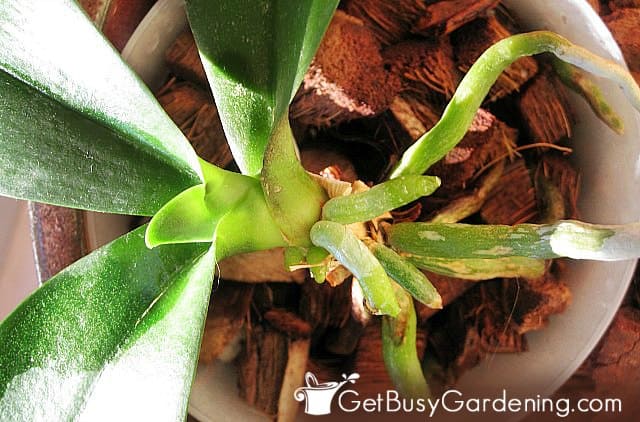
Propagating Orchids
The easiest and most common method of propagating orchids is to divide them. To divide a mature plant, remove it from the pot and carefully tease apart the roots.
Some types of orchids can also grow babies or offshoots at the base or along the flower stems.
Once they have their own roots, these babies can be removed and potted up into their own containers.
Many varieties can also be grown from seed, though this is fairly difficult and takes plenty of patience.
If you want to give it a try, just keep in mind that it can take several years for orchid seedlings to grow large enough to bloom.
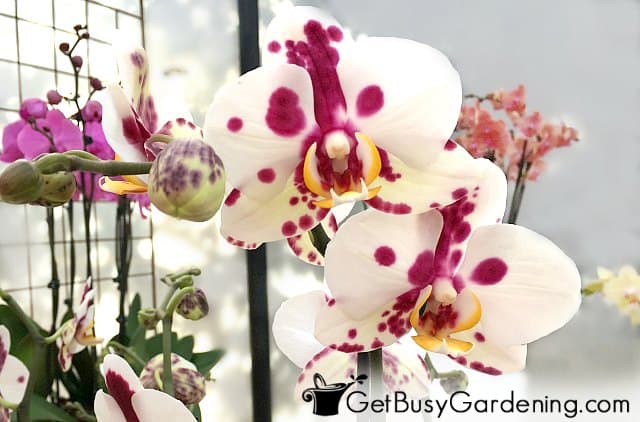
Troubleshooting Common Orchid Care Problems
When given the proper care, orchids are pretty easy to grow. However, there are several things that can go wrong, and sometimes it’s hard to figure out the cause.
So below I’ve included a list of some of the most common orchid care problems, the likely causes, and my recommended solutions.
Orchid Won’t Bloom
Most of the time, this is caused by temperature. They need cooler temperatures in the fall and winter to flower.
But it can also be caused by lack of light, using the wrong fertilizer, or your plant needs to be repotted.
Brown Leaves
When orchid leaves turn brown, it’s usually due to improper watering (mostly under watering). But brown leaves could also be caused by sunburn or fertilizer burn.
Never allow the medium to dry out completely, keep them out of the full sun, and always use a half or quarter dose of organic fertilizer.
Orchid Plant Is Dying
The most common cause of orchid death is improper watering. Overwatering usually happens when you use the wrong type of potting soil.
But yours could be dying because of under watering and/or lack of humidity. Check the potting medium to ensure it never dries out completely.
Leaves Turning Yellow
When the leaves turn yellow, it’s almost always due to overwatering, which can easily happen when epiphytes are planted in regular potting soil.
Allow the soil to dry more between waterings, or repot it using the proper growing medium.
Drooping Or Wilted Leaves
If the leaves are drooping or wilting, then it’s probably not getting enough water and/or humidity.
But drooping leaves could also be caused by overwatering, or happen when the plant gets too hot.
Flowers Dying Or Dropping Off
Orchid flowers naturally die back after a couple of months, which is completely normal. Keep them in a cool location to extend the bloom time.
Once the flowers have all died, and the spike has turned brown, then prune it off all the way down to the base.
Orchid Plant Care FAQs
In this section, I will answer some of the most commonly asked questions about growing orchids. If you still have a question after reading through all of this, then ask it in the comments below. I’ll be happy to answer it as soon as I can.
Are orchids hard to grow?
It depends on the variety you have. Some varieties are harder to grow than others. If you’re looking for an easy one to start with, get yourself a phalaenopsis (aka “moth”) orchid. Those are the easiest to grow, and perfect for beginners.
Can orchids be planted in soil?
Do not make the mistake of planting epiphytic orchids in regular potting soil. Their roots need plenty of space and air to thrive. Burying the roots in soil will only smother them, and they will eventually rot.
What do you do with an orchid after the blooms fall off?
Some will bloom several times, so leave the flower stem on the plant until it turns brown. Once it has died back, then you can prune all the way down to the bottom of the stem.
Do orchids need a lot of sunlight?
Orchids like lots of bright, indirect sunlight, but never full sun. Direct sunlight can burn their leaves. If you don’t have much natural light in your home, then I recommend using a grow light for them.
Where should orchids be placed?
Indoors, place them in an east or west facing window, or give them filtered sunlight from a south facing window. Outside, put them in a partial shade location, where they’ll be protected from the hot afternoon sun.
Can you use ice cubes to water orchids?
Using ice cubes for watering orchids seems to be a common trend, and I get asked about it quite a bit. However, I do not recommend doing this.
Since most types are tropical plants that come from warm climates, using ice on them could end up causing major damage. So, I recommend you stick to using room temperature water instead.
Growing orchids is a fun hobby, and can become very addicting! Plus there are tons of different varieties that you can collect. Simply follow these orchid plant care instructions, and you’ll enjoy yours for many years to come.
If you want to learn all there is to know about maintaining healthy indoor plants, then you need my Houseplant Care eBook. It will show you everything you need to know about how to keep every plant in your home thriving. Download your copy now!
More Houseplant Care Guides
- How To Care For An Orchid Cactus Plant
- Rabbit’s Foot Fern: How To Grow & Care For “Davallia fejeensis”
Share your orchid plant care tips or secrets in the comments section below.
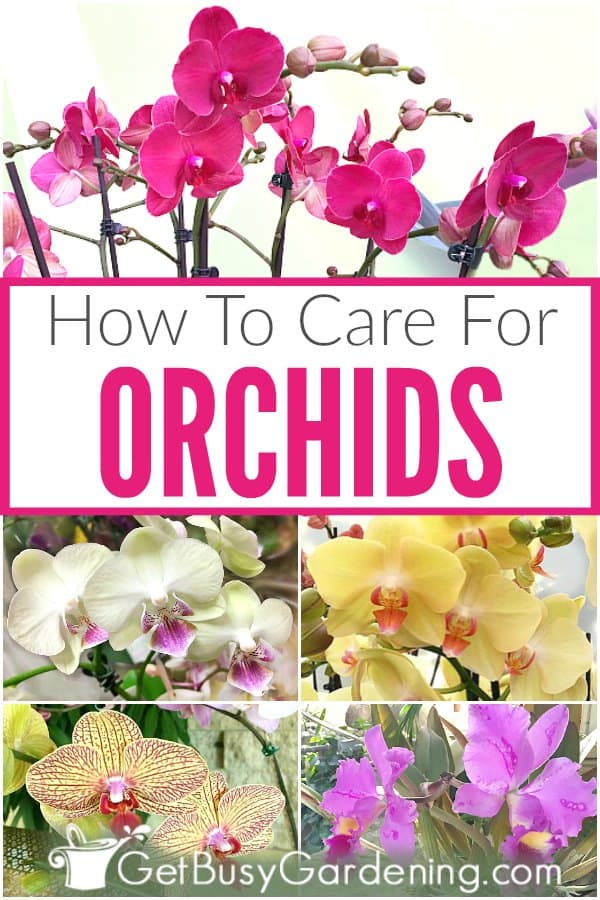
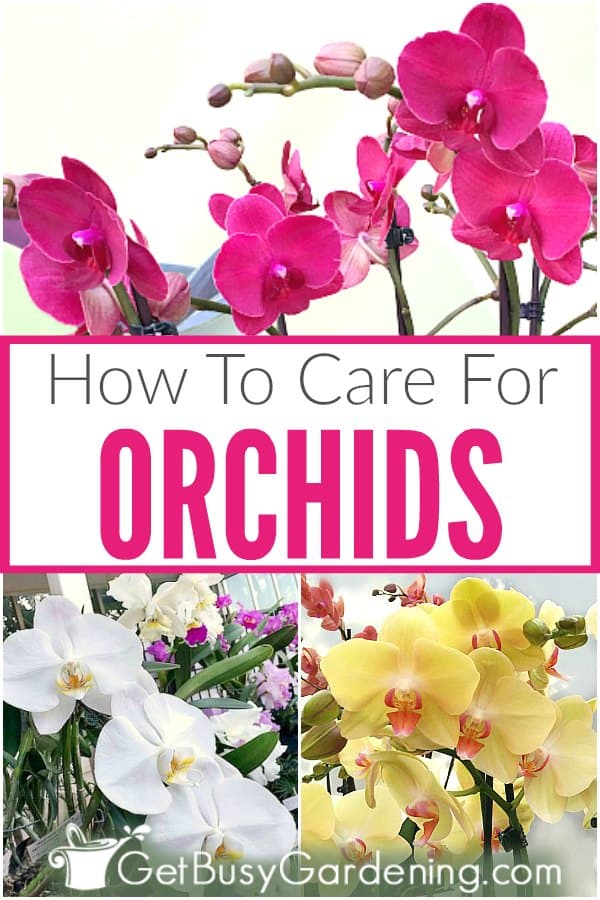


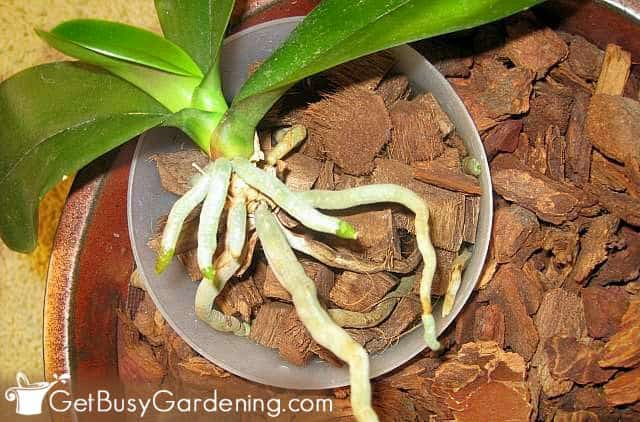


Pat says
I have a few orchids which seem to survive on neglect however my friend keeps giving me more orchids when they stop flowering and I now have about a dozen in my house !!! the one she gave me and fascinates me is the one where all the roots are hanging out of the pot and running about 1./2 a meter outside the pot! I tried to get it out of its pot cover only to find that the plant was totally out of the bark soil and just sitting on top of the bark!!!! I have just been spraying the hanging roots with water on the very casual basis and it is now in full bloom again. What can I do to keep it happy? trying to repot would be difficult as the roots are so long….
Amy Andrychowicz says
Wow, sounds like you have the right touch! If the orchid is happy basically just sitting on top of the medium, then why not try mounting it on a board or log? That would be fun!
Shirley says
I have long “spikes” on my orchid plant. What are they and can I cut them off?
Amy Andrychowicz says
When spikes develop on an orchid plant, they are either the start of a flower or new roots. Either way, I would not recommend cutting them off.
Nancy says
I was given an orchid as a gift, but I’m afraid that my plant will die, because in the past I’ve had no luck with orchids. However one of my leafs is wilting with a little yellow starting around it. What should I do?
Amy Andrychowicz says
Shriveling and/or drooping orchid leaves is usually caused by improper watering – either over or under watering. They like to be kept consistently moist, so most people tend to under water the plants. They also like a lot of humidity, so you may need to work to increase that if your home is very dry. Read the “Watering” and “Humidity” sections above for more details.
sheilabetsy says
Hi, I just gave my daughter loves orchids and has quite a few fake ones so I surprised her with a real live one on her recent b’day. Oh, you should have seen me in the store trying to choose the best looking one, lol . . . took me almost an hour! The tag attached to the plant said it should only be watered with an ice cube twice a week. Now, after reading your care guide, I’m a little confused. I’m asking on her behalf since I’m quite certain I’ll be the one actually caring for her plant, lol.
Amy Andrychowicz says
It’s funny how many people ask me about watering plants with ice cubes. It seems that many types of plant tags recommend doing that, and I have no idea why. Orchids are tropical plants that are sensitive to cold, so it seems dangerous to water them with ice cubes (especially for newbies). And if the ice was placed on top of the roots, I would be worried that it would cause damage to them. Anyway, I recommend watering your orchid with tepid water. You can wait until the medium is dried out, then water it really well until water is running out of the drainage holes and the medium is wet. Allowing the pot to soak in water so that it can absorb the water from the bottom also works great.
Cate says
My orchid (phal) was a gift I didn’t really want, somehow, with next to zero care it has not only survived, but still flowers. Today I decided to give it some love. I have trimmed off everything brown and faded and papery. Now it looks like it is climbing out of the pot! Is it best to pot it in a deeper pot? Also something has grown out of the bottom of the pot, looks like a whole new plant, could this be so? Thanks for the info from this page!
Amy Andrychowicz says
LOL, beginners luck I guess! 🙂 Yes, if your orchid has outgrown it’s pot, then you could repot it into a larger one, just be sure you use a potting medium for orchids rather than regular potting soil. The thing that’s growing out of the bottom of the pot could be a new baby orchid plant, or it could just be more roots.
kathy says
I have an orchid that is growing out of its pot , it is standing taller than the pot. Is there a way to cut it and put both in soil ? Sorry I’m not very good at explaining things drives my hisband nuts . Its the first one that I got so I was wondering I have looked and the ones I see thst may help are not in English and I’m not smart enough to read a different language lol
Amy Andrychowicz says
Since orchids are epiphytic plants, it’s common for them to grab onto the outside of the pot once they grow larger. You don’t want to bury the roots like you do with other plants. So, if your orchid has become too large for it’s current pot, then I would buy some orchid potting medium and a larger pot, and repot it. Plant it in the new pot at the same depth as it is in the current one. Then just keep doing what you’re doing because it sounds like you have one very happy orchid plant. 🙂
di says
Do you need to cut off the stem once the flowers drop off the orchid?
Amy Andrychowicz says
Leave the flower spike on your orchid, because more flowers could still form. You can cut the stem off once it dries out and turns brown.
Margie says
Oops! I cut the flower stem off my orchid while it was still green. Any advice?
Margie
Amy Andrychowicz says
No worries. Now you just wait for new flower spikes to grow from your orchid. 🙂
Helen Reynolds says
Thanks for this. I was recently given a beautiful orchid and I have been wondering if I could get it to bloom again when it stopped. I am pinning this for later!
Amy Andrychowicz says
You’re welcome!! Good luck with getting your orchid to bloom again!
SiestaSister says
Make sure that your Phal gets at least a week of temps below 55 at night. I had bought one that was in bloom and I kept it in the house. We were living in NC then. It never bloomed again until we moved back to Florida and I moved it outside. Once it went through fall when the night temps dropped….it bloomed. I later read an article which said that it needed the cold night temps to bloom.
Amy Andrychowicz says
Thanks for adding your tips for getting your orchid to rebloom. That is fantastic!
Rainforest Gardener says
Looks like your orchid is well on its way to blooming! Personally I like the fleshy roots of moth orchids just as much as the flowers, but thats just me. 🙂 My mom has a phal that’s just starting to put out a flower spike, and it just finished blooming in summer! That would make two blooms in one year, so I hope its not just a fluke.
Amy Andrychowicz says
Wow, her orchid bloomed twice in one year? That is wonderful!
p3chandan says
Your Phalaenopsis orchid looks healthy with new shoots coming out. Mine just bloomed this month too. Thanks for sharing the information and hope yours will have spikes soon!
Amy Andrychowicz says
You’re welcome! Congrats on your orchid blooming, that is very exciting!